Supplying the Frontline: Ukraine’s Drone Logistics
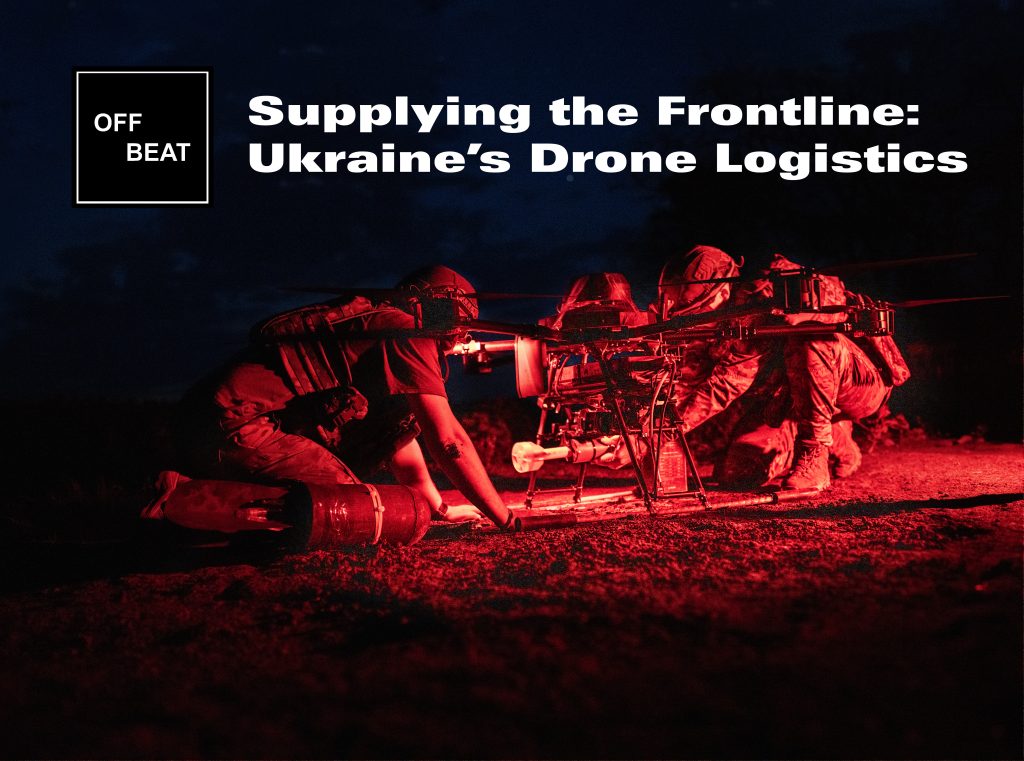
In the dark pre-dawn hours of the early morning, a group of seemingly featureless soldiers stand in one of the countless empty fields dotting the hostile territory on the front between Dnipro and the Russian-controlled Donetsk oblast.
In near pitch darkness, their forms meld together. They move at once, illuminated by nothing more than the dim red glow of their headlamps. Back and forth they trudge, hoisting one dark shape onto another dark shape, latching them together, then retreating back toward the tree line.
Tonight, like all nights since their rotation, these soldiers belong to the night bomber team of the Ukrainian Armed Forces’ 59th Assault Brigade — specialists in unmanned aerial warfare. And they move in darkness, under the eerie glow of dim red light, less for cinematic effect and more to avoid being targeted by the Russian drones constantly prowling the night sky.
These warfighters are hurriedly attaching bombs, and sacks loaded with supplies, onto a “Vampire” drone — a domestically produced, multi-rotor drone with onboard infrared (IR) technology and a particular penchant for vicious night bombing runs.
Among Russian forces unlucky enough to be on the receiving end, Ukraine’s Vampire drone is mythologized as “Baba Yaga”, the malevolent witch of Slavic folklore. In the cold October daylight, these bombers appear much larger and more fearsome than the commonly used FPV and Mavic drones known for dropping hand grenades on poorly sheltered Russian soldiers. This increased airframe size also allows a heavier payload, granting the Vampire drone additional flexibility to carry out both bombing raids as well as much-needed supply missions.
The advent of drone warfare has severely impacted the functionality of military supply chains. Amid the proliferation of Russia’s cheap drone fleet, huge swaths of the Ukrainian frontline have been turned into functional no-go zones, making resupply and medevac difficult and often impossible.
This makes the role of the heavy bomber drone, and its operators in the 59th Assault Brigade, all the more critical. With the Vampire’s heavier carrying capacity of around 30lbs (13.6kg) and its pre-equipped IR sensors, Ukraine is afforded the newfound ability to transport desperately needed food, water, and ammunition to its forces scattered across the frontline.
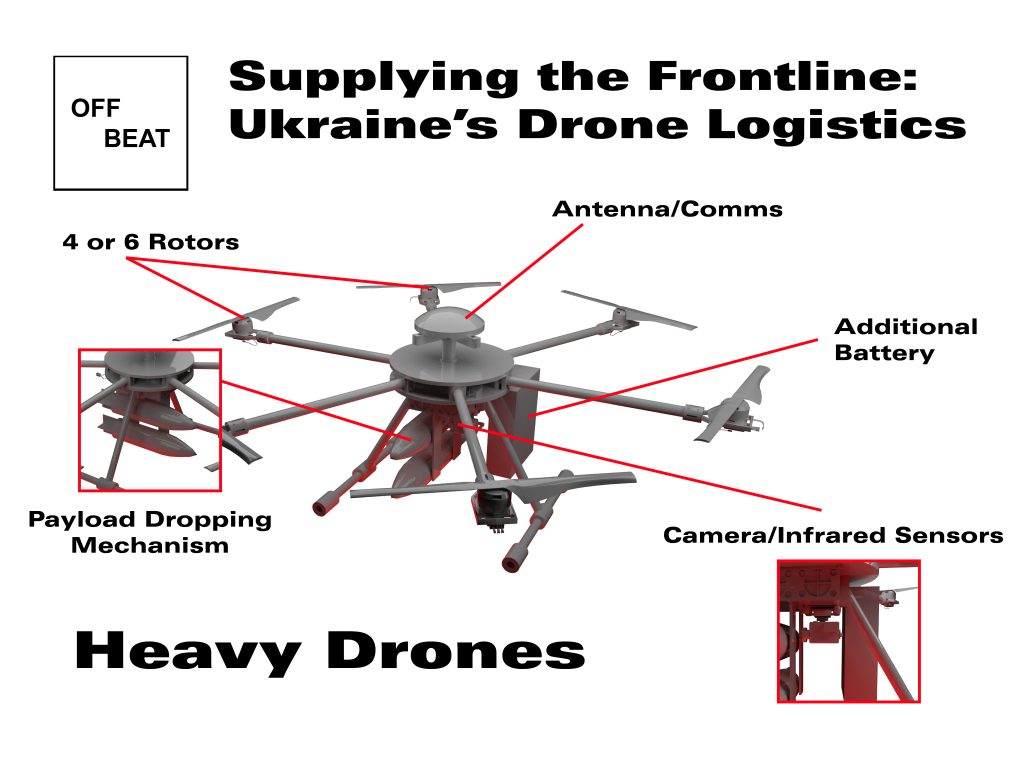
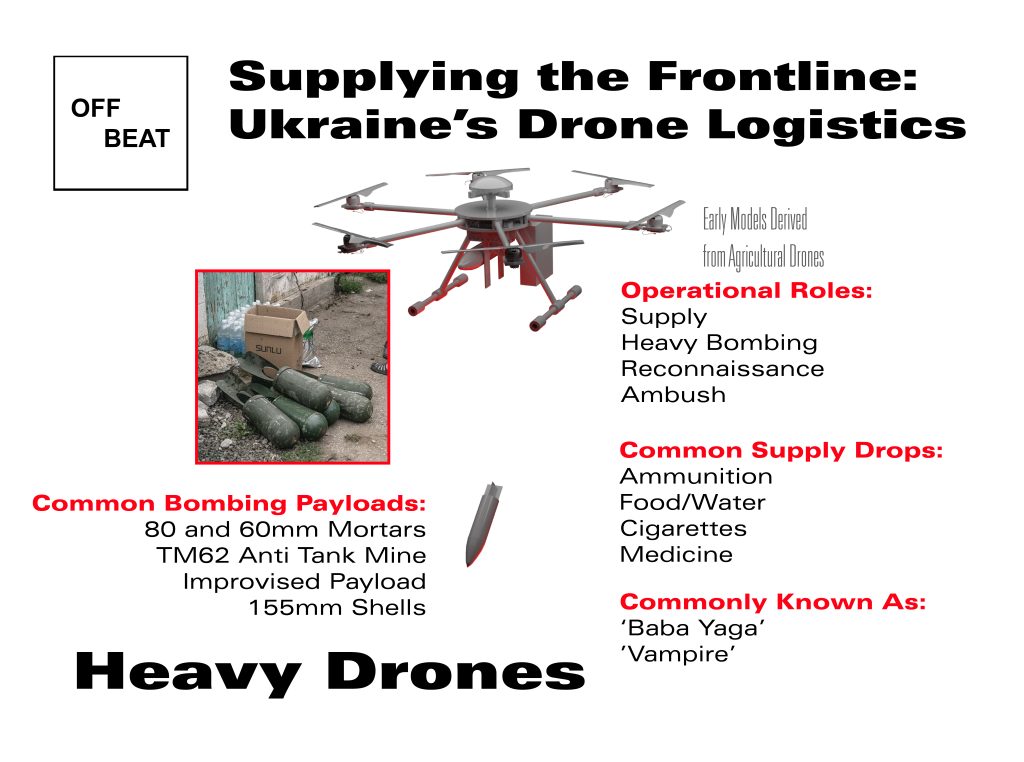
They are also afforded the ability to transport densely packed high-explosive payloads onto enemy targets in the dead of night, striking fear and uncertainty into the hearts of Russian soldiers below. This is the mission for which Vampire drones are most well-known, and the mission which, not so long ago, these crews spent most of their time carrying out.
My first time embedding alongside these teams, in 2024, I followed a crew of the Ukrainian National Guard on mission in the Lyptsi axis of the Kharkiv region. The entire time these Guardsmen carried bombs heavy enough that they had to squat down and lift with their knees just to load them onto the drones. They dropped bomb after bomb, waiting patiently for the Vampire drones to return from their sorties before hauling another payload carefully above ground, fitting it to the fuselage, and sending it off once more.
The Guard crew I embedded with spent their time receiving intelligence on enemy activity — the positions and movement of Russian infantry, mortars, and drone teams — then raining a stream of heavy bombs (with great malice and extreme prejudice) onto the heads of those soldiers sleeping carefully in their dugouts below. In the downtime, these Guardsmen would masquerade as mailworkers, playing postman by signing their payloads in Sharpie before starting the process of shipping and delivery.
Since my embed on the Lyptsi axis, I’ve filmed several more of these teams in and around the Donetsk region in 2025. These teams have proliferated, and their role has also expanded significantly from a largely assault-focused mission to a joint tasking comprising both assault and support operations. In particular, Vampire teams have been given an increasing number of logistical assignments in support of Ukraine’s strained supply chains — a drone-based solution to a drone-caused problem.
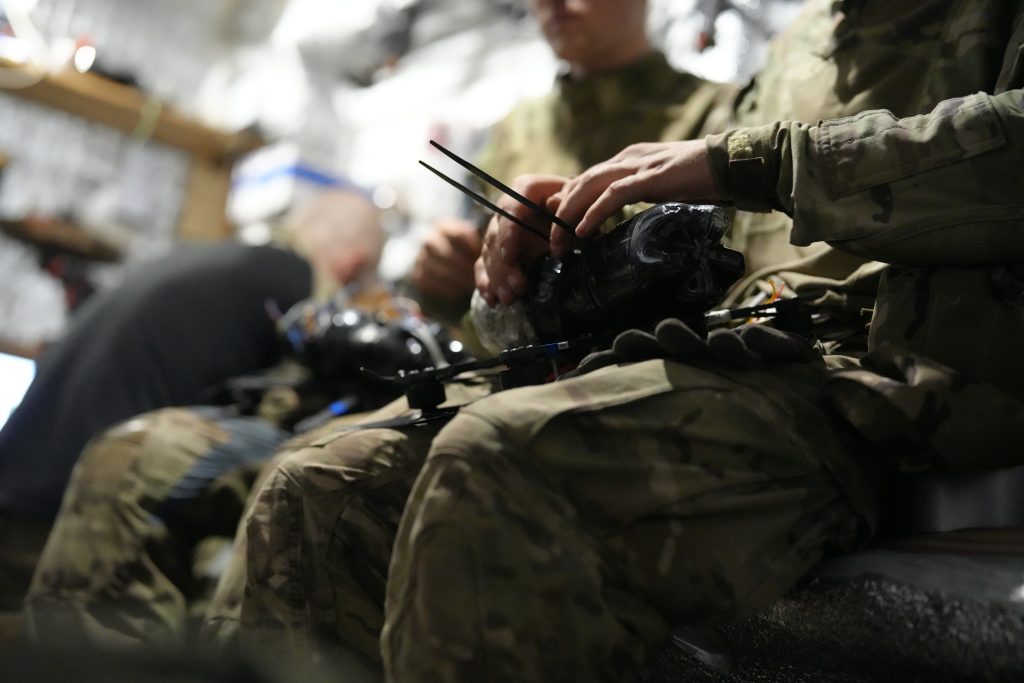
Soldiers equip an FPV drone with a makeshift fire bomb for deployment on the front. // Photo credit: Dylan Burns
Supply chains on the front are traditionally maintained by ground, via truck transport; through selective force rotations; or through conventional manned cargo aircraft, like helicopters and airplanes. But with the proliferation of Russian ground-to-ground and air defense systems (ADS), and the broader embrace of frontline drone warfare, the traditional mode of resupply has become problematic. Many Ukrainian soldiers trucking supplies to those on the front have lost their lives by a relentless wave of Russian artillery, MLRS rockets, mortars, and drones tasked with hunting for any signs of movement.
This has prompted a re-think of logistical methods by military leaders in Kyiv, keen on avoiding any further incitement of the country’s growing manpower shortage. Vampire drones have been helpful here, and field-tested in many high-risk circumstances: instances where soldiers have been isolated from nearby ground supply lines, or encircled by Russian infantry encroaching through the treelines, are helped in some way by the advance of Vampire drones delivering much-needed aid under the cover of night.
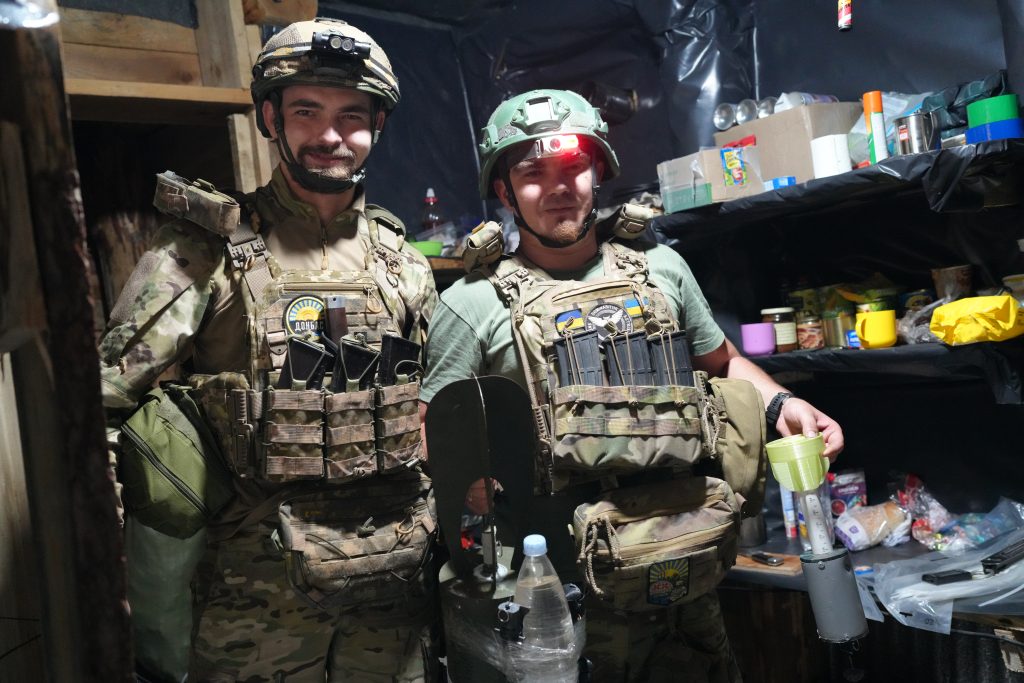
The men of the 59th strap supplies to makeshift glide bombs for deployment to friendly soldiers over the front. // Photo credit: Dylan Burns
On the border of Dnipro and Donetsk, the soldiers of the 59th Assault Brigade spend their time under the cover of darkness carrying out this exhausting and often life-threatening work. On one side, soldiers load up supplies to be dropped on friendly positions communicated over radio by command. On the other, soldiers load up bombs the size of a fat beagle, to be dropped on enemy positions communicated over radio by command.
On the resupply side, the 59th Assault Brigade fills up burlap sacks with food, ammunition, and jugs of water bound tightly in bubble wrap (to prevent a watery explosion upon impact). These resupply sacks are then lofted into the sky on the Vampire’s buzzing rotors, where it carries them some distance away and drops onto a designated drop zone, the location and timing of which is closely coordinated with command in order to minimize personnel movement. In this manner, when affecting a resupply, the armed forces risk only the cost of a $20,000 drone instead of the lives of multiple soldiers. Nonetheless, the lives of the pilots are very much in danger, as they often work to hide from recon drones and are a high priority for Russian drone pilots.
Still, ground-based resupplies remain necessary. While Vampire drones remain an excellent option for carrying moderate explosive payloads, the approximately 33lb (15kg) carrying capacity often provides soldiers on the front with little more than a middling stream of small arms ammunition, sausages, energy drinks, and cigarettes.
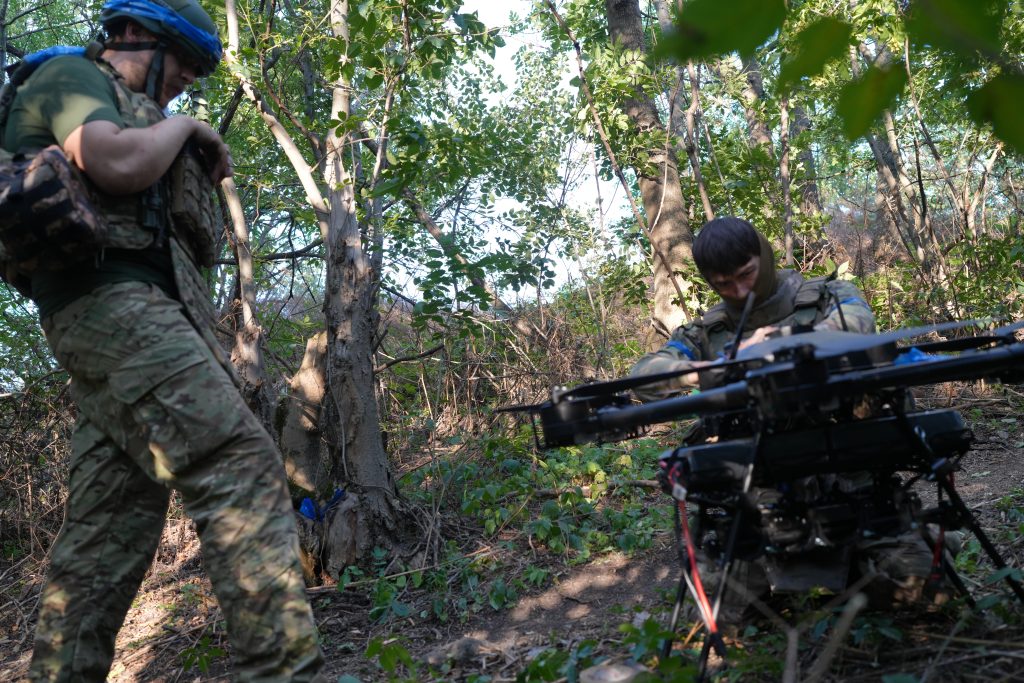
Soldiers from the 20th “Lyubart” Brigade set up a heavy bomber drone during one of their daytime runs. // Photo credit: Dylan Burns
On a separate mission in July, I embedded alongside a heavy drone team from the 20th Brigade of Operational Assignment “Lyubart”, a group of warfighters which split off in 2025 from the Azov Brigade during the latter’s restructuring into a corps format. Here, the team suffered losses and had shifted their strategy towards a mix of both daytime and nighttime runs, to increase operational efficiency and allow more time for bombing runs and aid deliveries.
We arrived from a nearby FPV drone launch position, and were quickly informed by the 20th Brigade that their night bomber drone — already rigged together with duct tape and faith — had just caught enemy fire and sustained damage.
To make matters worse, their Starlink router started to suffer an outage which ultimately lasted two and a half hours. Ukrainian forces have relied on Starlink systems to provide real-time FPV drone video feeds across various sectors of operation since Elon Musk’s SpaceX first extended services to Ukraine in 2022, but traditional communications are still carried out via radio channels.
Despite this, the team still wanted to work, and the treeline in which we hid was covered from end to end in badly needed supply sacks waiting to be dropped on soldiers defending Konstantynivka. So they attempted to field-repair the damaged drone, but this was unsuccessful. The only thing that seemed to work was the startup chime, which played John Williams’ Imperial March (of Star Wars fame) every time it was powered on.
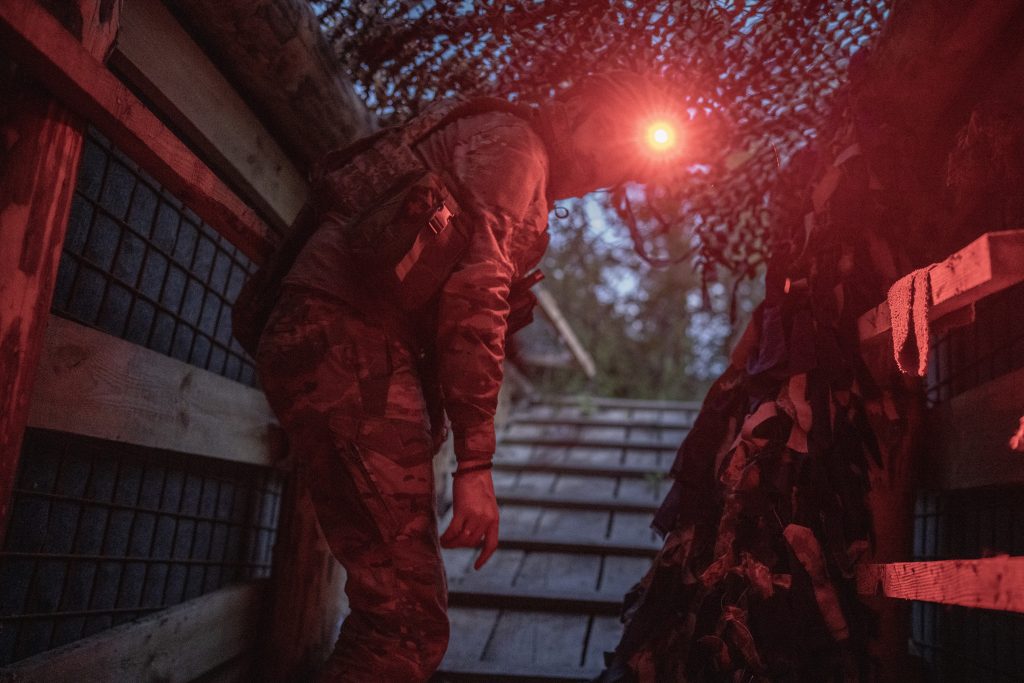
Soldiers from the 59th hurry out of their foxhole to perform drone work. // Photo credit: Dylan Burns
Drones are growing increasingly involved in logistical work, which has evolved into a new reality of modern warfare and supply chain management.
As a tool of warfare, drones are highly flexible: they’ve even been used for medevac purposes, in one case delivering an e-bike to a wounded Ukrainian serviceman who needed to make a quick getaway. Certain units, like the Ukrainian National Guard’s 13th “Khartia” Brigade, run ground-based drones and have sought in recent months to substantially expand the role and operationality of such drones under their command. These ground-based drones are arguably as flexible as their aerial counterparts, being used in both support and attack capacities — the latter of which is usually accomplished by retrofitting remote controlled machine gun turrets or TM-62 anti-tank mines to the drone’s chassis.
The flexibility of Ukraine’s drone operations may be a saving grace for the country’s manpower shortage, which has affected all sectors of the Armed Forces. Preserving soldiers’ lives is undoubtedly a motivating factor for those in command, who have sought to pile resources and R&D into drone programs. And further research in this field may surpass present technical limitations, like inclement weather, signal dead zones, or limited weight capacity.
In this sense, the theater of war in Ukraine exists at the forefront of 21st century warfare, a herald for the future of combat as state and non-state actors around the world increasingly embrace drones as an integral aspect of their military strategy.
Ironically, the same drone tech that makes this job so deadly for rotating troops on the frontline has also been one of the factors which has enabled their continued survival. This developing technology is transforming what was once a mission where soldiers had to roll the dice with their lives, into one where they only have to gamble with a piece of equipment that doesn’t have parents waiting for it to come back home.
